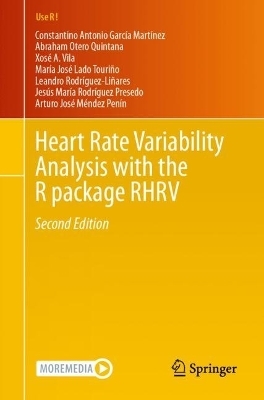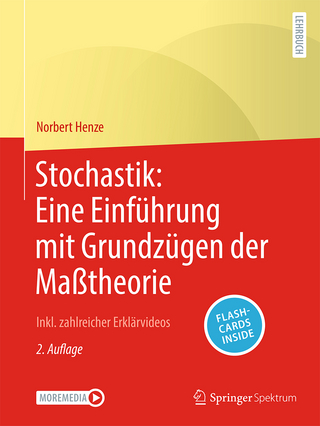
Heart Rate Variability Analysis with the R package RHRV
Springer International Publishing (Verlag)
978-3-031-65752-8 (ISBN)
This book introduces readers to the fundamental concepts of Heart Rate Variability (HRV) and its most important analysis algorithms using a hands-on approach based on the open-source RHRV software. HRV refers to the variation over time of the intervals between consecutive heartbeats. Despite its apparent simplicity, HRV is one of the most important markers of autonomic nervous system activity and it has been recognized as a useful predictor of several pathologies. The book discusses all the basic HRV topics, including the physiological contributions to HRV, clinical applications, HRV data acquisition, HRV data manipulation and HRV analysis using time-domain, frequency-domain, time-frequency, nonlinear and fractal techniques.
Detailed examples based on real data sets are provided throughout the book to illustrate the algorithms and discuss the physiological implications of the results. Offering a comprehensive guide to analyzing beat information with RHRV, the book is intended for masters and Ph.D. students in various disciplines such as biomedical engineering, human and veterinary medicine, biology, and pharmacy, as well as researchers conducting heart rate variability analyses on both human and animal data.
The second edition of the book has been updated to RHRV version 5.0. This version introduces a functionality to perform heart rate variability analysis on entire populations. This functionality automates and streamlines both the calculation of HRV indices in the time, frequency, and nonlinear domains, as well as the subsequent statistical analysis.
Constantino Antonio García Martínez earned his Ph.D. in Computer Science from the University of Santiago de Compostela. He is currently an associate professor of Computer Science and Biomedical Engineering at San Pablo CEU University. His main research lines are linked to the application of Bayesian and machine learning models to complex signals, especially in the field of electrocardiography and the analysis of heart rate variability. He is coauthor of more than 12 scientific papers, and more than 17 contributions at conferences and symposiums.
Abraham Otero Quintana was born in Orense, Spain in 1978. He received a B.Sc. in Physics in 2000 (with honors), and a Ph.D. in Computer Science from the University of Santiago de Compostela. In 2006 he moved to San Pablo CEU University, where he cofounded the Laboratory of Bioengineering and created the Biomedical Engineering degree course. Currently he is Full Professor at the University CEU San Pablo, and visiting professor at the University of Turabo, Puerto Rico. He is coauthor of 54 scientific papers and over 70 contributions at conferences and symposiums, most of them in the field of biosignal processing.
Xosé A. Vila received a B.Sc. and Ph. D. from the University of Santiago de Compostela with a thesis on HRV. He was an associate professor of Computer Science there, and has been an associate professor of Computer Science at the University of Vigo since 2006. He is coauthor of 39 scientific papers and 77 contributions at conferences and symposiums, half of them about HRV, and he has led and participated in various research projects related to HRV. From 2011 to 2018 he was the head of the Center for Research, Transfer and Innovation at the University of Vigo.
María José Lado Touriño was born in 1971 in Santiago de Compostela (Spain). She received a B.Sc. and Ph.D. in Physics from the University of Santiago de Compostela, in 1995 and 1999, respectively. She is presently associate professor of Computer Science at the University of Vigo. Her research interests include computer-aided diagnosis systems in medical imaging and biomedical signal processing. She is author of nearly 50 papers in scientific journals, 15 books and book chapters, and more than 50 contributions at conferences and symposiums on biomedical signal processing.
Leandro Rodríguez-Liñares was born in 1967 in Santiago de Compostela (Spain). He received a B.Sc. in Pharmacy from the University of Santiago de Compostela in 1990 and a B.Sc. in Telecommunications Engineering from the University of Vigo in 1994. He also obtained his Ph.D. in Telecommunications Engineering from the same university in 1999, where he is currently associate professor in Computer Science. He is author of more than 60 papers in scientific journals and contributions at conferences and symposiums on natural language interfaces and biomedical signal processing.
Jesús María Rodríguez Presedo received a B.Sc and Ph.D. in Physics from the University of Santiago de Compostela, Santiago de Compostela, Spain, in 1989 and 1994, respectively. He is currently a researcher at the Centro Singular de Investigación en Tecnoloxías Intelixentes, University of Santiago de Compostela. His research interests include biomedical digital signal processing, heart rate variability, nonlinear dynamics, soft computing and the development of ubiquitous healthcare systems.
Arturo José Méndez Penín was born in 1969 in Ourense (Spain). He received a B.Sc. from the University of La Laguna in Physics, and a Ph.D. from the University of Santiago of Compostela. He is an associate professor at the Department of Computer Science of the University of Vigo. His research interests include biomedical signal processing, mainly in ECG and HRV, and computer aided diagnosis. He is coauthor of more than 25 scientific papers a
- 1. Introduction to Heart Rate Variability.- 2. Loading, Plotting and Filtering RR Intervals.- 3. Time Domain Analysis.- 4. Frequency Domain Analysis.- 5. Nonlinear and Fractal Analysis.- 6. Comparing HRV across Different Segments of a Recording.- 7. Putting it All Together, a Practical Example.- 8. Automating HRV analysis: RHRVEasy.
| Erscheinungsdatum | 28.09.2024 |
|---|---|
| Reihe/Serie | Use R! |
| Zusatzinfo | XIII, 189 p. 55 illus., 34 illus. in color. |
| Verlagsort | Cham |
| Sprache | englisch |
| Maße | 155 x 235 mm |
| Themenwelt | Mathematik / Informatik ► Mathematik ► Wahrscheinlichkeit / Kombinatorik |
| Schlagworte | fractal analysis • Frequency Domain Analysis • Heart rate variability analysis • Nonlinear analysis • Time Domain Analysis |
| ISBN-10 | 3-031-65752-7 / 3031657527 |
| ISBN-13 | 978-3-031-65752-8 / 9783031657528 |
| Zustand | Neuware |
| Haben Sie eine Frage zum Produkt? |
aus dem Bereich


